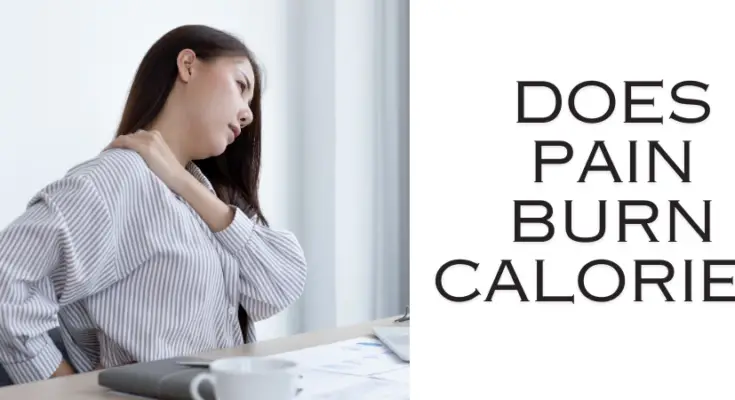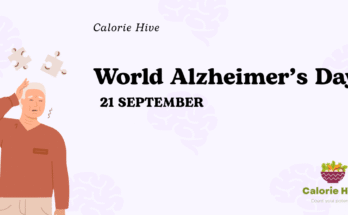Have you ever wondered whether does pain burn calories? It’s a curious thought, isn’t it? Depending on where the pain comes from, cramps can occur after intense workouts that not only burn calories and fats but also strengthen your muscles and increase your stamina.
The impact of calorie burn during an injury on the body depends on how severe it is, for example, some injuries require you to consume certain foods to recover quickly, which can aid you in losing weight and reducing calories. However, pain from other sources, such as aches, back pains, joint pains, etc, does not have any connection to burning calories.
Taking a closer look at the science behind pain and its potential impact on calorie burning, let’s determine whether pain aids in weight loss.

Relationship between Pain and Calories
The pain is your body’s way of saying that something should be done about the problem. It is your body calling for your help. This can be translated in different ways depending on the pathway, for example, it can be felt in the acute forms of a stubbed toe to the chronic ones like arthritis. Pain might be regarded as a negative sensation; however, it is greatly important when it comes to the protection of the body from hurt and the alarm of possible dangers.
Calorie is a measurement of energy that our body requires to complete its various functions, which includes movement, digestion and also to maintain normal metabolic rate. With each meal eaten, the body converts the food into calories, of which some portions can be metabolized immediately and the rest is kept and used whenever needed.
Remember! Pain is simply a sensation triggered by the nervous system in response to stimuli, and it does not have a metabolic effect on its own. Pain does not burn calories directly.
Muscle Mass: In the case of muscle cells versus fat tissue, the latter burns more calories at rest.
Sex: The greater muscle mass which is likely in men is the reason behind the higher basal metabolic rate (BMR).In order to keep weight, the intake of calories should be between the amount of calories burned out to the activity and other bodily functions. Usage of more calories than what our bodies can utilize for the production of energy will lead to the storage of excess, which is fat formation in the body, thus weight gain.
Burning Calories with Injuries
Pain often accompanies muscle damage, particularly after a strenuous workout. This damage triggers a repair process within your body. To rebuild and strengthen your muscles, your body burns calories. This process, known as Excess Post-exercise Oxygen Consumption (EPOC), can elevate your calorie burning for several hours after exercise.
Here’s where pain becomes indirectly linked to calorie burning: Sore muscles can sometimes limit your movement. You might move slower or avoid certain activities due to discomfort. This decreased activity level can lead to a slight increase in calorie burning compared to your usual routine. However, it’s important to note that this is a minor effect.
Calories consumed differs according to the period of time the individual is sick which is affected by the type of virus/illness type one have. For example, fever causes more calorie expenses so if one is sick more the metabolism tends to be quicker but if the disease is less severe, the heightened metabolism will be less the case
After all, losing calories as a result of illness, when the energy levels of the body are used for fight against a disease, also occurs. Sometimes, the body can increase production and the rate of metabolism that can burn off calories more than if the body is to stay under normal conditions.
If you suffer from a constant pain, then it is crucial that you consult a medical expert to find out its root and obtain proper treatment. Do not forget, a balanced diet and enough physical activity and exercise are the most effective way in managing weight and improving your overall health condition.
Emotions, Pain and Calorie Burning

It’s important to note that while short-term stress responses may temporarily increase calorie burning, chronic stress can have the opposite effect, leading to weight gain and metabolic imbalances. Finding healthy ways to manage stress, such as through relaxation techniques, exercise, and social support, is crucial for overall well-being.
Focus being on Recovery as Sole Engine, not on Pain-Induced Calorie Burning.
Here are some key takeaways:
- First and foremost, make sure you execute the recovery well after exercise. Pay attention to yourself and take a day of rest if required.
- Work on a balanced diet, which supplies your body with the nutrients it requires for the restoration process and helps boost its normal functioning.
- As you go about your daily routine of the activities that supports your health make sure that you exercises your muscles as well by spending a reasonable amount of time that is free of intense pain. This causes the increase of muscle, which in turn increase the BMRs and promote the burning of calories leading to the increase of total calorie burn.
Did you know? Crying is thought to burn roughly the same amount of calories as laughing – 1.3 calories per minute, according to one study
Additional Considerations
Chronic pain problem is a complex issue and may have a great negative effect on ours quality of life. If you feel the pain is going on and it does not fade away gradually, you should consult a medical practitioner and get a medical checkup done to know the underlying issue of your pain and utilize the right treatment accordingly.
Regardless of whether pain directly burns calories, exercise remains one of the most effective ways to increase calorie expenditure and support weight management. Regular physical activity not only burns calories during the activity itself but also boosts metabolism and promotes muscle growth, both of which contribute to long-term calorie burning.
Additionally, exercise offers a wide range of other health benefits, including improved cardiovascular health, enhanced mood, and reduced risk of chronic diseases like diabetes and heart disease. Whether you enjoy brisk walks, yoga sessions, or weightlifting workouts, finding activities that you enjoy and can incorporate into your routine is key to maintaining a healthy lifestyle.
Conclusion
The issue of “pain or calories” is a question of interpretation. Calories burning due to the very action of pain itself doesn’t really make up for a noticeable amount of calories at all. This state also functions as a message from your body to you that something needs careful attention.
However, pain can be indirectly linked to calorie burning in a couple of ways:
Muscle repair after exercise: Through so-called muscular cleanse, your body burns calories during the reparative shedding of lactic acid and debris.
Limited movement due to pain: Sometimes, your pain can limit your movement, which contributes to a minimal amount of extra calories burnt, in contrast to your usual activity level.
The main conclusion on the matter is that the calorie burning brought about by pain isn’t a safe or reliable approach of weight management.
Instead, prioritize these strategies:
Proper recovery after exercise: Listening to your body, try and schedule in the rest days when requested.
Balanced diet: Check under your hood and make sure the engine gets its due oil, fuel, and the rest of the car your specially formulated diet.
Regular exercise: Try motions and actions that work muscle groups without too much aching of your muscles. This is key for increasing muscle mass together with improving your basal metabolism that delivers more energy to the body for burning the overall calories.
You may also like to read: Do Massages Burn Calories, Is this for real?
Does a Driving Burn Calories? l You Absolutely Need To Know This




